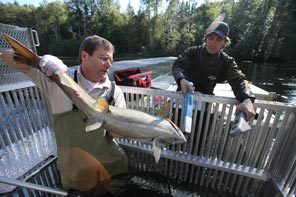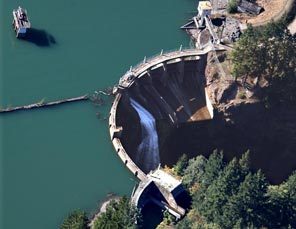Originally published Saturday, September 17, 2011 at 7:04 PM
Will giant chinook salmon return? Dam-removal project opens the door
Bringing back the Elwha River kings, the most storied in Puget Sound, has been a rallying cry for advocates of dam removal for more than a generation.
Seattle Times staff reporter
STEVE RINGMAN / THE SEATTLE TIMES
Kent Mayer of the Washington Department of Fish and Wildlife lifts an adult chinook captured in a temporary weir set up across the Elwha so scientists can sample and tag fish before returning them to the river. Elwha chinook once reached enormous size, growing to 100 pounds.

THE DAMS
Story: An unprecedented restoration effort
THE HISTORY
Timeline: An Elwha River chronology
Video: Building dams, powering the economy
THE SALMON
Story: Will giant chinook salmon return?
Graphic: The five species of Elwha salmon
THE TRIBE
Story: The ancestors' prayers answered
Video: A talk with elder Adeline Smith
REVEGETATION
Story: Restoring a healthy watershed
THE SEDIMENT
Story: Biggest-ever sediment release
Graphic: Picturing 24 million cubic yards
CHAT REWIND
Behind the scenes of the Elwha special report
PROJECT HOME
![]()
Banging around like a bull in a rodeo chute, the big chinook rattles the metal pen holding her at a fish weir on the Elwha River.
A biologist struggles as the big fish slams around, and, finally getting his hands on her, lifts the fish from the water. Her tail fin is as wide as his spread fingers, and her midsection big and meaty. Working her snaggletoothed jaw methodically, the hen, fat and ripe, extrudes a few eggs the size of a pinkie nail, bright and glowing red.
The biologist finishes logging, measuring and tagging her, then slips her back into the water. She rockets away into the green depths of the Elwha with a thrash of her tail, sending water flying. Left to head upriver to spawn, she'll make it just a few more miles — before she is stopped at Elwha Dam, just five miles from the river mouth. Stopped dead, perhaps: Built without fish passage, the dam has blocked 70 miles of habitat above it since construction began in 1910. Elwha fish runs once numbered some 390,000 strong, according to the National Park Service. By 2010, runs of fall chinook like this one, the most prized fish of all in the river, had fallen to a record low of only about 500.
If Elwha River ecosystem recovery has a poster child, it is this fish. Bringing back the Elwha River kings, the most storied in Puget Sound, has been a rallying cry for advocates of dam removal for more than a generation.
Staying out in the ocean seven years or longer, Elwha fall chinook used to grow to enormous size, 100 pounds and more. William Roy Clark, of Maple Valley, remembers the photos his grandfather, Frank Clark, the first powerhouse operator at Elwha Dam, took of the fish killed in the blasting of the spillway at the bottom of the dam: "There was one that made a huge impression on me and my sisters that showed a chinook that hung from the front porch beam of the big house on the road down at the dam and its nose touched the second step down." The fish were used to feed the construction crews.
The river was once home to 10 species of oceangoing fish, and there wasn't a season of the year without juvenile fish migrating to sea, adults returning to spawn, or young fish maturing before heading out to saltwater. All five species of Pacific salmon thrived in the Elwha. Pinks used to swarm the river, feeding the entire watershed with their overwhelming biomass, so many fish filling the river that they startled horses.
When the dams come out, scientists expect salmon to vigorously recolonize the river. That's happened before where disturbances, from landslides to volcanic eruptions, have blocked the flow of a river.
An all-new, industrial-scale hatchery built at the direction of the park service at a cost of more than $16 million for the Lower Elwha Klallam Tribe as part of the recovery project also will be used to plant fish in the river. The hatchery is controversial — particularly the tribe's plan to also release non-native steelhead. Scientists warn that hatchery fish pose unnecessary risks to fragile wild runs.
The tribe has agreed to a moratorium on fishing in the river for five years after the dams come down. But then, the tribe wants something to catch — and native fish probably still will not be ready to sustain a fishery. Scientists caution it could take some 20 to 30 years to see recovery well under way.
Salmon are tenacious creatures, that much is for sure. Every August and September they still come back, swimming as far as the face of the dam, where they hold, motionless, waiting to go upriver. At first, in the water, they look like shadows. Then logs. Then something spooks them, and the quicksilver fact of these fish, so big, still here, comes alive. Eventually, after reaching the lower dam, they give up, turn and head back downstream to spawn.
But the limited spawning area and the lack of suitable habitat have hurt productivity. Some years, the water below the lower dam has been so warm it has forced emergency evacuations of adult salmon by biologists, who net them from the river and spawn them artificially, for fear of otherwise losing the run.
Will the big fish come back? Some who know them best have no doubt.
"I had a dream that one day, I was an old man, watching salmon jumping up the canyon," said Mel Elofson, an Elwha Klallam tribal member who is on the tribe's fishery staff. "Maybe that was a premonition. I hope so."

















